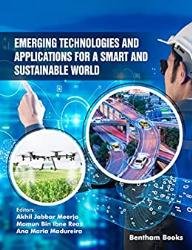 Название: Emerging Technologies and Applications for a Smart and Sustainable World
Название: Emerging Technologies and Applications for a Smart and Sustainable WorldАвтор: Akhil Jabbar Meerja, Mamun Bin Ibne Reaz
Издательство: Bentham Books
Год: 2022
Страниц: 240
Язык: английский
Формат: pdf (true), epub
Размер: 13.9 MB
This reference distills information about emerging technologies and applications for smart city design and sustainable urban planning. Chapters present technology use-cases that have radical novelty and high scalability with a prominent impact on community living standards. These technologies prepare urban and rural dwellings for the transformation to the smart world. Applications and techniques highlighted in the book use a combination of Artificial Intelligence (AI) and IoT technologies in areas like transportation, energy, healthcare, education, governance, and manufacturing, to name a few.
Machine Learning Process of smart building (SB). ML techniques are successfully trained to solve computer vision problems like speech recognition, gesture recognition, compression, etc which gives greater scope for such models to be applied in smart building context as smart building problems cannot be solved by conventional methods but the appropriate solution could be learned only from data. For successful results, ML needs a large amount of data for training and the massive sensor data collected using IOT sensors for designing smart building supports ML modeling.
AM5729 BASED Beaglebone AI IOT GATEWAY
This is an intelligent gateway built on the proven BeagleBoard.org open source Linux approach. Artificial Intelligence (AI) fills the gap between small smart building computers and more powerful industrial computers. The specifications are: Processor Dual Arm Cortex with VLIW DSPs. An on-chip RAM capacity of 2.5 MB is available. Coprocessor namely dual ARM Cortex processor is also integrated with this gateway. Extra features of the Embedded Vision engine and industrial communication subsystem are integrated. Graphics accelerator and programmable real time unit are some more additional features.
Artificial neural network (ANN) plays a vital role in a smart building application. Smart building application approaches infer knowledge about the occupants, devices, and energy profiles of buildings. There are two main types of neural network learning namely supervised and unsupervised learning. In supervised learning, the learning occurs in the presence of targeted data called labels while unsupervised learning groups data based on similarities among them. Supervised learning is commonly preferred for the smart building approach. The foremost supervised learning tools are Feedforward Network (FFN), Support Vector Machine (SVM), Linear Regression (LR), Decision Tree (DT), and Radial basis function (RBF) network.
The book serves as a learning resource for smart city design and sustainable infrastructure planning. Scholars and professionals who are interested in understanding ways for transforming communities into smart communities can also benefit from the cases presented in the book.
Table of Content:
PREFACE
IOT-based Smart Energy Management in Buildings of Smart Cities
RF Energy-based Smart Harvesting Systems
A Survey on Security Aspects of Internet of Vehicles
Smart Technologies: Technologies Transforming Cities from Vision to Reality
Blockchain: The Vibrant Technology for the Management of a Smart Cities
Multi Lingual Smart Virtual Personal Assistance: A Step towards Improving Life of Specially Able Society
Farm Doctor: Smart App Using Deep Learning Multi Class Model for Crop Disease
Environmental Monitoring and Management
Evaluation of the Application Potential of Metamaterial-based Antennas for Intelligent Street Lighting Systems
Скачать Emerging Technologies and Applications for a Smart and Sustainable World